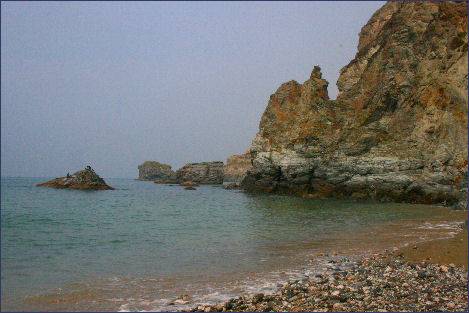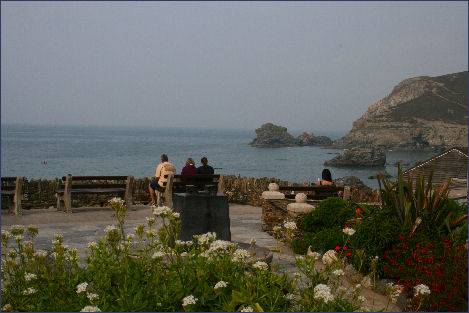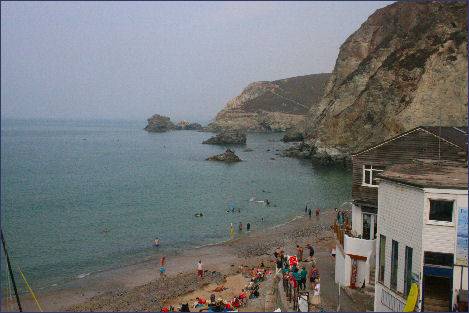St. Agnes
OS Grid ref:- SW713507
The picturesque village of St. Agnes on the Atlantic west coast of Cornwall is steeped in mining history, with the demise of the mining industry in Cornwall, St Agnes became a popular tourist resort.


St Agnes retains a traditional friendly Cornish atmosphere and makes a superb base for a holiday. The village, set amongst some of the finest scenery in Cornwall, boasts characterful old stone built shops and cottages, some dating back to the early eighteenth century.
The village has a variety of shops, grocers, a pharmacy, a bank, post office, newsagents, as well as craft shops, galleries and workshops where beautiful gifts are made by hand, and several pubs and restaurants. There is also as a range of accommodation to suit all budgets.


The St. Agnes Beacon stands high on the cliffs above the village and is now owned by the National Trust, the views from its summit are panoramic. St. Agnes derives its old Cornish name Bryanick, meaning pointed or prominent hill, from this dominant landmark. The cliff walks around St. Agnes pass many old solitary mine ruins. Wheal Coates is one of the best known and most picturesque groups of cliff-top mine buildings in Cornwall, offering superb coastal views.
A coastal footpath from the village leads to St. Agnes Head, which encompasses views of a thirty mile sweep of the Atlantic coast from Trevose Head, nine miles from Newquay, to St. Ives.
 Since mining ceased, early in the last century, the village has become a quiet and unspoiled community. At the top of Town Hill a row of old slate roofed cottages, which go
by the name of 'Stippy Stappy', line the route down the steep incline to the harbour.
Since mining ceased, early in the last century, the village has become a quiet and unspoiled community. At the top of Town Hill a row of old slate roofed cottages, which go
by the name of 'Stippy Stappy', line the route down the steep incline to the harbour.
The St. Agnes Parish Museum contains exhibits which detail the landscape and the history of St. Agnes. The Museum is run local by volunteers and is a registered charity established to promote the heritage of the village. The mining and seafaring history of St. Agnes are vividly explained in displays and on film. Free parking is available in the main car park in the centre of St. Agnes village.
Bolster & Chapel Porth is a large earthen bulwark which dates from the Dark Ages. It originally ran from Chapel Porth to Trevaunance Cove. According to legend, Bolster was a giant who fell in love with a young maiden named Agnes. As proof of his love, so the legend relates, Agnes demanded that the giant fill a small hole at the edge of the cliff with his blood. Being such a small hole the giant willingly did so. However, he was unaware that the hole was bottomless and opened into a sea cave. Bolster continued to fill the cave until he was so weak that he fell into the sea to his death; the blood-stained cave can be found at Chapel Porth.
The harbour nestles in Tevaunance Cove, which has a labyrinth of caves. The area is excellent for surfing and there are beach huts for hire. The mainly pebble beach is covered with rock pools, in which the retreating tide abandons a variety of small sea creatures. Swimming is not recommended due to the unpredictable currents in the area. Lifeguards operate on the beach in the summer months.
Places to visit around St. Agnes
*St. Agnes Parish Museum contains collection of exhibits related to local history. Open:- Easter - end of October, daily, 10.30am - 5pm
*St. Agnes Beacon extensive views, brilliant heather, ruined engine houses standing high on the cliffs, owned by the National Trust.
*Blue Hills Tin Streams at Trevellas. tour of the works, covers the process of rock to metal Open April - Oct Monday - Saturday 10.30am - 5pm.
*Tehidy Country Park at North Cliffs, free access, visitor centre on South Drive
A walk from St. Agnes to Trevaunance Cove
Duration 1.5 hours
*Commencing from St. Agnes village square, take the alley between Churchtown Arts and the Over the Moon Gallery which is signpposted 'the Beacon'. Pass the cottage across the road, pass the playground and follow the lane.
*Continue along the lane until reaching a five-bar gate with a stile beside it, cross the stile and keep to the trodden path, cross four 4 fields and four more stiles to reach Beacon Road. Cross the road to the foot path on the other side. This path will take you around the bottom edge of St. Agnes Beacon onto Beracon Drive.
*On arrival at the road cross over and follow the road straight ahead to St. Agnes Head picnic area and the coastal path. Where the road bears left there is a car park, turn right, there are several grass tracks that lead down to the main footpath signposted Newdowns Head. Continue along the footpath around Newdowns Head, PolberroCove and down to Trevaunance Cove.
*Just past a row of terraced cottages on the right turn up onto the marked footpath, on arrival at Rocky Lane turn right to ascend steeply up the slope. On approaching the second bend on the left you will see a rough footpath which crosses the driveway of Wheal Friendly Chalets, climb up some steep steps for superb views of the cove below.
*Continue up the foot path past Wheal Friendly Engine House to Trevaunance Road, turn left to return to the village. Turn right in front of St.Agnes Parish Church to reach the village square.